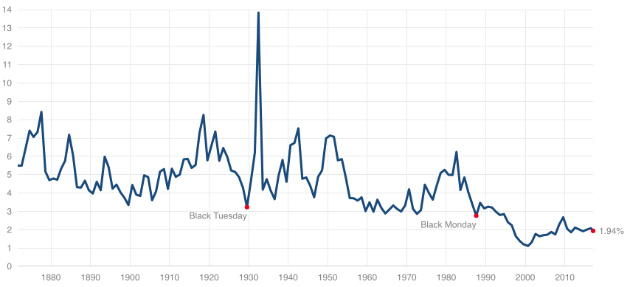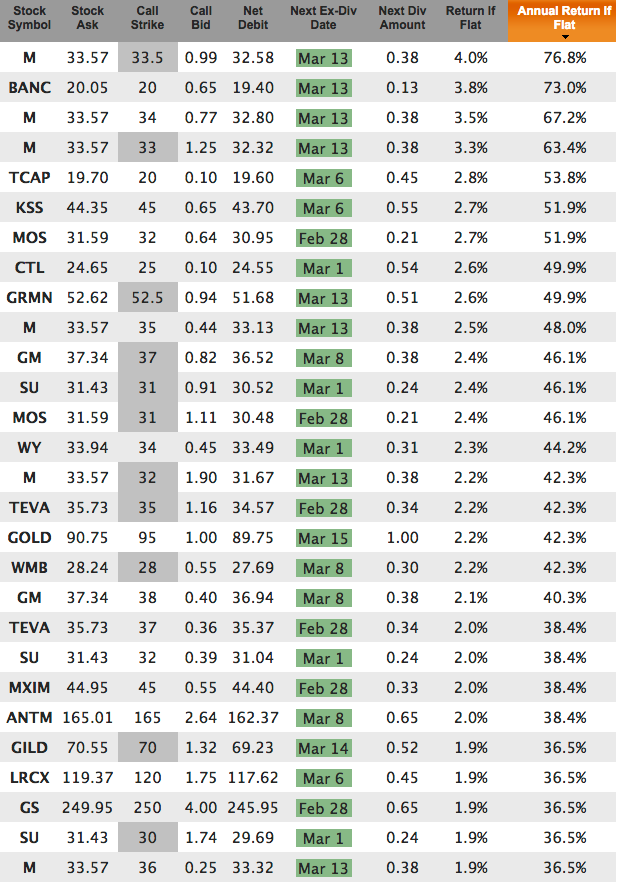Dividend Capture With Covered Calls
"The only thing better than an asset that produces an income stream is an asset that produces TWO income streams."
- typical covered call investor
This article shows how to generate two income streams (dividends and option premium) from a single asset (shares of stock). We'll also show a brief video on how to use software to quickly find good dividend stocks to write covered calls on.
Dividends
Most large companies pay dividends. In fact, 84% of the S&P 500 companies (420 of the 500 companies) pay dividends. There are some notable (large) companies among the 80 that do not pay dividends: Amazon, Facebook, and Google, for example. These companies are reinvesting their profits for new growth initiatives rather than return it to shareholders.
Current Dividend Yield
As of today, Feb 27, the S&P 500 average yield is 1.94%. Relatively low but not surprising given an 8 year bull market that has increased stock prices, as well as the current low interest rate environment (which means that companies don't need to pay high dividends to attract investors).
Historically, the S&P 500 average dividend yield has been higher, typically above 3% for the 100 years prior to Black Monday in 1987:
 Of course, that 1.94% is an average. Many S&P 500 companies pay quite a bit more than that.
Of course, that 1.94% is an average. Many S&P 500 companies pay quite a bit more than that.
Top 10 Dividend Yields In S&P 500
Some stocks pay nearly double the average dividend yield. For example, here are ten S&P 500 stocks that currently have a dividend yield of 3.6% or more:
Company |
Symbol |
Price |
Est Div |
Div Yield |
|---|---|---|---|---|
| American Electric Power | AEP | 64.76 | 2.44 | 3.77% |
| Consolidated Edison | ED | 74.52 | 2.78 | 3.73% |
| Gap | GPS | 25.03 | 0.93 | 3.72% |
| ExxonMobil | XOM | 81.89 | 3.04 | 3.71% |
| Exelon | EXC | 35.92 | 1.32 | 3.67% |
| SCANA | SCG | 66.96 | 2.45 | 3.66% |
| Weyerhaeuser | WY | 33.98 | 1.24 | 3.65% |
| WEC Energy Group | WEC | 58.07 | 2.11 | 3.63% |
| International Paper | IP | 52.76 | 1.90 | 3.60% |
| Public Storage | PSA | 227.73 | 8.20 | 3.60% |
3.6% Per Year Income Stream
If all you wanted was a 3.6% per year income stream, you could just buy a portfolio of stocks that had an average dividend yield of 3.6% per year or more (such as those above).
But if you want even more income, then you can layer on a covered call strategy on top of dividend paying stocks. Before we talk about that, let's review when you need to own a stock in order to receive its dividend.
Ex-Dividend Date
A stock's Ex-Dividend Date (also known as ex-div date or ex date) is the first day the stock trades without the dividend. In order to receive the dividend you must own the stock by the close of market on the day before the ex-dividend date.
For example, if a stock has an ex-div date of March 5, you must own the stock by close of market on March 4 in order to receive the dividend.
If you sell your stock before the ex-div date then you will NOT receive the dividend.
Likewise, if you buy the stock on the ex-div date you will NOT receive the dividend.
If you want to hold the stock for as little time as possible and still get the dividend, you can buy the stock just before the market closes the day before the ex-div date and then sell the stock just after the market opens on the ex-dividend date. You may make or lose a little on the stock, but you will get the dividend for sure.
Other Dividend Dates (Which You Can Ignore)
Although the ex-dividend date is the only date that matters to most investors, there are 3 other dates that relate to dividends: declaration date, record date, and payable date. Although important, all you need to focus on is the ex-div date. As long as you own the stock by the end of day on the day before the ex date then you will get paid the dividend (although you won't receive the money until the payable date).

The declaration date is the date the company declares the dividend (approves and announces it). This is just an informational date and can vary from days to weeks prior to the ex-dividend date. It only matters because a dividend isn't official until it is declared by the company's Board of Directors.
The record date is the date by which you need to be a shareholder of record in order to receive the dividend. It is normally 2 days after the ex-dividend date because it takes a couple of days for share transactions to settle. So you have to buy the stock before the ex date in order to have the transaction settle (i.e. be a shareholder of record) on the record date. Holidays come into play sometimes, too. But you can ignore all this and just focus on the ex date to know if you're going to get the dividend or not.
The payable date is the day you actually receive the cash from the dividend. It can be days to weeks after the record date. You can sell your stock before the payable date and still receive the dividend payment (as long as you own the stock the day before the ex-dividend date thru the morning of the ex date you will receive the dividend).
Why Ex-Dividend Dates Matter To Covered Call Writers
Sometimes covered call writers will be subject to early exercise (meaning, the buyer of the option will exercise his right to purchase your stock before the option expiration date) just so they can capture the dividend. If this is going to happen then it usually happens to ITM (in-the-money) options the day before the ex-dividend date. But normally it will only happen if the amount of time premium remaining in the option is zero or a few pennies.
Example Of Early Exercise
You own 100 shares of ABC stock, and it's currently trading at $51/share. You had previously sold a call option with a 40 strike, and that option is currently trading for $11 (at parity, no time premium remaining because it's 11 points ITM). ABC goes ex-dividend tomorrow and will pay a $0.50 dividend.
Will the option holder do an early exercise on you today?
Yes, because tomorrow morning (the ex-div date) the stock will open lower by the amount of dividend paid ($0.50), and deep ITM options will be lower by that same amount. In order to avoid a loss equal to the amount of the dividend, most deep ITM options with no (or very little) time premium remaining will be exercised.
If the option had more than a few pennies of time premium remaining then the option would probably not be exercised. Depending on the bid-ask spread for the option holder, as well as his commission rates, he would probably be better off just selling his option rather than exercising it.
And this is probably obvious but if a stock does not pay a dividend (and therefore has no ex-dividend date) then the odds of early exercise are practically zero (because the person doing the early exercise is giving up any remaining time premium -- he'd be better off just selling his option rather than exercising it).
Writing Covered Calls On Stocks About To Go Ex-Dividend
Shorting a call option on a stock you own just before its ex-dividend date is a common income-oriented strategy. Assuming the covered call is not exercised, you will receive both the dividend income and the call option income. Let's look at an example:
Example Dividend Capture With Covered Call
Example from Feb 22. The following day, Feb 23, is the ex-dividend date for CVI. The stock trades at 23.12 per share and the dividend is 50 cents. So, if we had bought 100 shares of CVI on Feb 22 and then sold a March 17 expiration, 25-strike call option (trading at 35 cents), we would have received both the 35 cents from the option and the 50 cents from the dividend. That's 85 cents per share of income in about a month on a $23 stock. Here's the math:
- Buy 100 shares of stock: $23.12 per share = $2312
- Sell 1 call option: March 17 expiration, 25-strike call option for 35 cents = $35 income
- Tomorrow's dividend of 50 cents = $50 income
Now, if we hold the stock until March 17 and if the stock is unchanged between now and then, we could sell the stock for $23.12 and our return would be:
- Total income = $85
- Total investment = $2312
- Return = 85 / 2312 = 3.67% in 24 days, which is 56% annualized
In The Money vs Out Of The Money Covered Calls
In the previous example the strike price ($25) was above the stock price ($23.12), which is the very definition of an 'out-of-the-money' (OTM) covered call. While there is potential for some upside capital gain (the difference between the strike price and the stock price), there is also risk that the underlying stock will go down before expiration, thus reducing or eliminating the income generated.
A way to reduce that risk is to use ITM (in-the-money) strike prices instead of OTM strike prices. Instead of a 25-strike we could have used a 20-strike, for example. This removes any chance of a capital gain but it provides much more downside protection. Because, if the stock drops from 23.12 to 20 you will still make a profit from the dividend and the option premium. If the stock drops below 20 then you may have a loss, depending on how far the stock drops. Nothing is risk-free.
How To Quickly Find Stocks About To Go Ex-Dividend
You can use software such as Born To Sell's covered call screener to identify all stocks that have a dividend coming up. Just use the Search Dividends feature and set the Expiration Date slider to the option expiration date you are most interested in. The software will find all stocks that have an ex-dividend date before your chosen option expiration date, and then show you matching covered calls. Here is a 3-minute video of this dividend capture feature and process:
140 Opportunities Per Month
If we only count the 420 S&P 500 dividend-paying stocks, and if we assume they pay dividends 4x per year (quarterly), that's 1680 dividend capture opportunities per year, or about 140 per month. The challenge is being able to find them quickly, and at the same time remove high-risk situations such as an earnings release before expiration, or super high P/E ratio stocks. The Born To Sell software does all of this for you.
Example Dividend Screen
Here is a screen shot of the results from a covered call dividend capture screen for the March expiration, with earnings releases (i.e. high volatility risk events) removed, as of today. Many of these are in-the-money, and all of them have an Annualized Return If Flat of 36% or more (greater than 3%/month):

Cool, huh? Want more? Sign Up For A Free Trial
Mike Scanlin is the founder of Born To Sell and has been writing covered calls for a long time.
